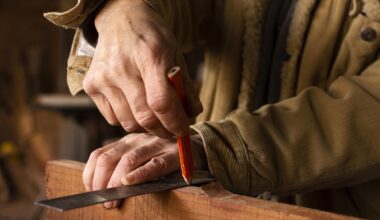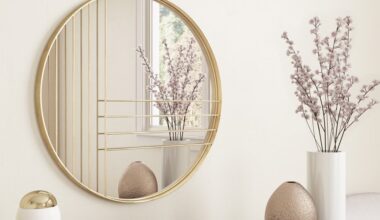A good office rug can transform your home office into a cozy yet functional space.
So, how should you choose the perfect rug to match your home office?
Factors like rug size, shape, rug type, material, color, style, etc., should be considered while buying a rug for your home office. Your home office shape and size, colors, or style also determine the choice of the rug.
Since work from home is a popular work model, you would want to customize your home office to be more comfortable.
This article will guide you in choosing a rug for your home office, considering all the factors.
Table of Contents Show
Things to Consider While Choosing a Rug
Choosing a rug for your home office is not all about decorating the home office. The right rug can make your home office more functional and reflect your style too.
1. Size of the Rug
A good-sized rug is necessary to make the room look well-designed.
Generally, 4’ x 6’ to 5’ x 8″ rug size goes well with most home offices. A 9 x 12 size is ideal for the larger office. The rug must be at least 18” to 24” larger than the desk.
However, multiple considerations should be made when choosing the correct rug size for the home office.
Some of the useful considerations are mentioned below.
- You should first decide if the rug will be used as an area rug or a full-sized wall-to-wall rug.
- Areas that you need to access every day should be determined. For instance, if you need to reach the shelf in your home office constantly, the edge of the rug should at least reach the furniture.
- If you are looking for a large-sized rug, look for one that fills up the space yet does not overwhelm the room. Look for a rug size that leaves at least 18 inches between the rug’s end and the wall.
- You can have a 5×8 rug placed parallel to the desk.
Refer to the table below for tips on choosing rug size and shape based on room size.
| Rug Size | Room Size | Recommended Rug Shape |
|---|---|---|
| 3 to 5 foot | 5 to 7 foot | Round |
| 5 to 7 foot | 7 to 10 foot | Square |
| 7 to 12 foot | 10 to 12 foot | Sqaure |
| 9 to 12 foot | 11 to 14 foot | Square |
2. Pile Height of the Rug
According to Jaipur Rugs, the pile height of a rug relates to the density of the fibers in the rug- flat (short pile) or shaggy (long).
In layman’s terms, rug pile height refers to the thickness of carpets and rugs measured from the surface to the backing.
High-pile rugs are usually taller than 1/4″. These rugs are noted for their luxurious, comfy, and warm feel.
Indentations from furniture legs will show up more on a high-pile rug than on a low-pile rug.
On the other hand, rugs with low pile heights prevent allergens from becoming trapped within the fibers and help produce a smooth surface.
Rolling the chairs are easier on a low pile rug. A rug of height less than half-inch is ideal for home office use.
The perfect pile height of the rug also depends on the carpets already placed in the office.
For instance, if the carpet is already a few inches thick, using thick rugs might make it more difficult to roll your chair around.
Pros of Using a Low-Pile Rug
- It enables easy chair movement.
- The chair wheels won’t get caught in the rug.
Cons of Using a Low-Pile Rug
- Low-pile rugs do not provide enough warmth to rest your feet on.
- They can slide and shift while moving chairs if used without backing.
If you are looking for a patterned low pile rug, Unique Loom Trellis Frieze Collection Area Rug is a perfect choice.
3. Shape of the Rug
The shape of the rug also determines the space used and the overall outlook of your home office. A small round rug would fit in perfectly if you have a small room and less floor space.
However, a square rug will be a good choice if you have a square-shaped room. The square-shaped rug will also complement your square-shaped desk.
Likewise, pair up round and rectangular rugs with round and rectangular desks.
Things to Consider Before Choosing the Shape of the Rug
- Make sure to measure your room size before choosing the rug shape.
- Measure the size of furniture in your home office.
- You also need a general idea of how the room will be used. For example, if the room is going to have a separate area.
- Choose the rug shape according to the traffic in that particular area.
- Consider the room’s overall style and aesthetics before choosing the rug shape.
Below are the best features of each shape of the rug.
Round or Oval Rugs
- Round rugs provide a cozy look to the home office.
- You can use round rugs in small rooms to make them appear large.
- It can be paired with rectangular or circular furniture.
- If you choose round rugs, you can place furniture on them to separate a designated area.
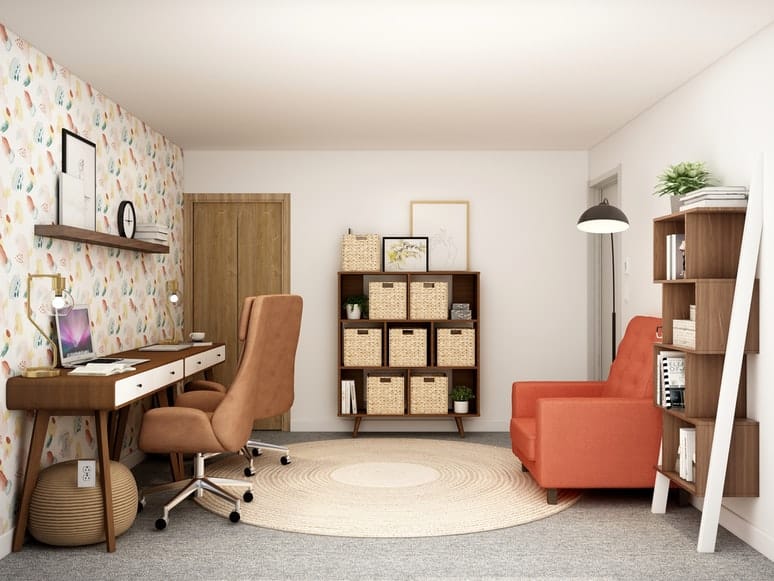
You can get a nice woolen rug for your home office like this LEEVAN Traditional Collection Round Rug from Amazon.
Square Rugs
- Two rugs can be used parallelly when paired with square-shaped tables.
- Great for high-traffic home offices.
- Square rugs can be chosen to make your home office look bigger.
Rectangular Rugs
- Ideal for use in large home offices.
- Rectangular rugs are ideal for filling big square or oblong living areas with furniture that requires a lot of space.
- Rectangular Rugs work best for tight spaces.
A Classic Traditional Textured Rectangular Rug would be a great touch to your home office.
4. Construction of the Rug
A home office rug with the proper construction will make your workplace more appealing and even welcoming!
Because you will be spending a significant amount of time in this area, it will experience a lot of movement from you and your chair.
| Types of Rug | Properties |
|---|---|
| Hand-Loomed or Machine made | Lifespan of about 20 years |
| Hand-knotted rugs | Show minimal damage even after decades of usage. |
| Hand-tufted rugs | Affordable and durable |
| Flat weave rugs | Easy movement of chairs |
| Hooked rugs | Not suitable for home office |
| Braided rugs | Reversible |
Hand-loomed or Machine Made
Hand-loomed or machine-made carpets cannot withstand the wear and tear of repeated chair movement, so you should choose a more durable type.
Depending on the fibers, most machine-made carpets have a lifespan of about 20 years.
Hand-knotted Rugs
These rugs are the most durable, showing minimal damage even after decades of usage, especially if they are made of wool.
Hand-knotted Persian rugs come in various styles and are a considerable investment that grows in value over time.
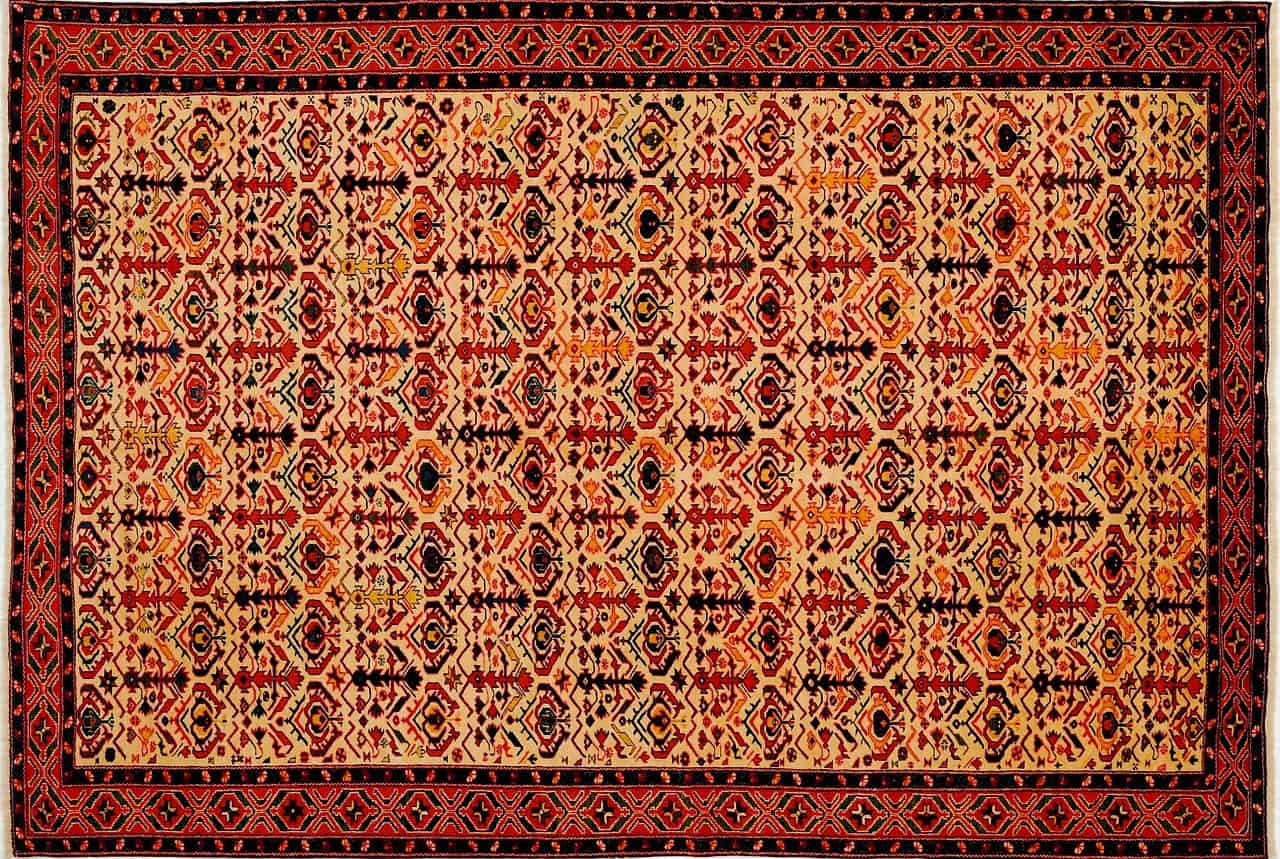
A hand-knotted ivory-colored woolen rug can be found on Amazon.
Hand-tufted Rugs
A hand-tufted rug is an excellent choice if you’re on a limited budget. These rugs are not as durable as hand-knotted rugs but are constructed with good materials.
Hand-tufted rugs may last anywhere from 5 to 10 years. The fact that tufted carpets shed is one of its disadvantages.
And because of its uneven surface, it can also lead to wobbling tables. Learn to fix the wobbling of the table on the carpet.
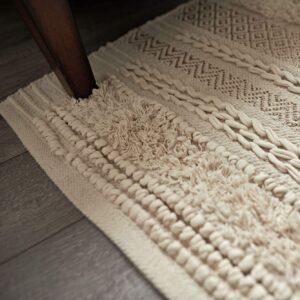
Safavieh Antiquity Collection Rug brings a classic look to your home office.
Flatweave Rugs
Flatweave rugs have no pile, so they do not shed. As a result, they usually contain less material overall, making them one of the lightest types of rugs available.
These carpets are more lasting because of their flatness, as flat regions or prints do not form as in other rugs’ designs.

They are pretty easy to maintain and are very durable. You won’t have to worry about tables or chairs tilting because the carpeting is thinner.
The nuLOOM Raina Flatweave bohemian rug brightens your space with its unique charm and color.
Hooked Rugs
Hooked rugs are handmade using a needle-like tool. Unfortunately, some hand-hooked rugs contain cheap transferable dyes that will bleed over time, making the rug look unappealing.
The glue used in the backing materials can include fillers that crumble and “powder” over time. This will eventually ruin the carpeting.
These rugs will last just 3-10 years with proper care in a low-traffic region.
Braided Rugs
Braided rugs are made by connecting several pieces of fabric strips. These rugs have the benefit of being reversible.
Therefore, if one side of the rug becomes dirty, the other may be used.
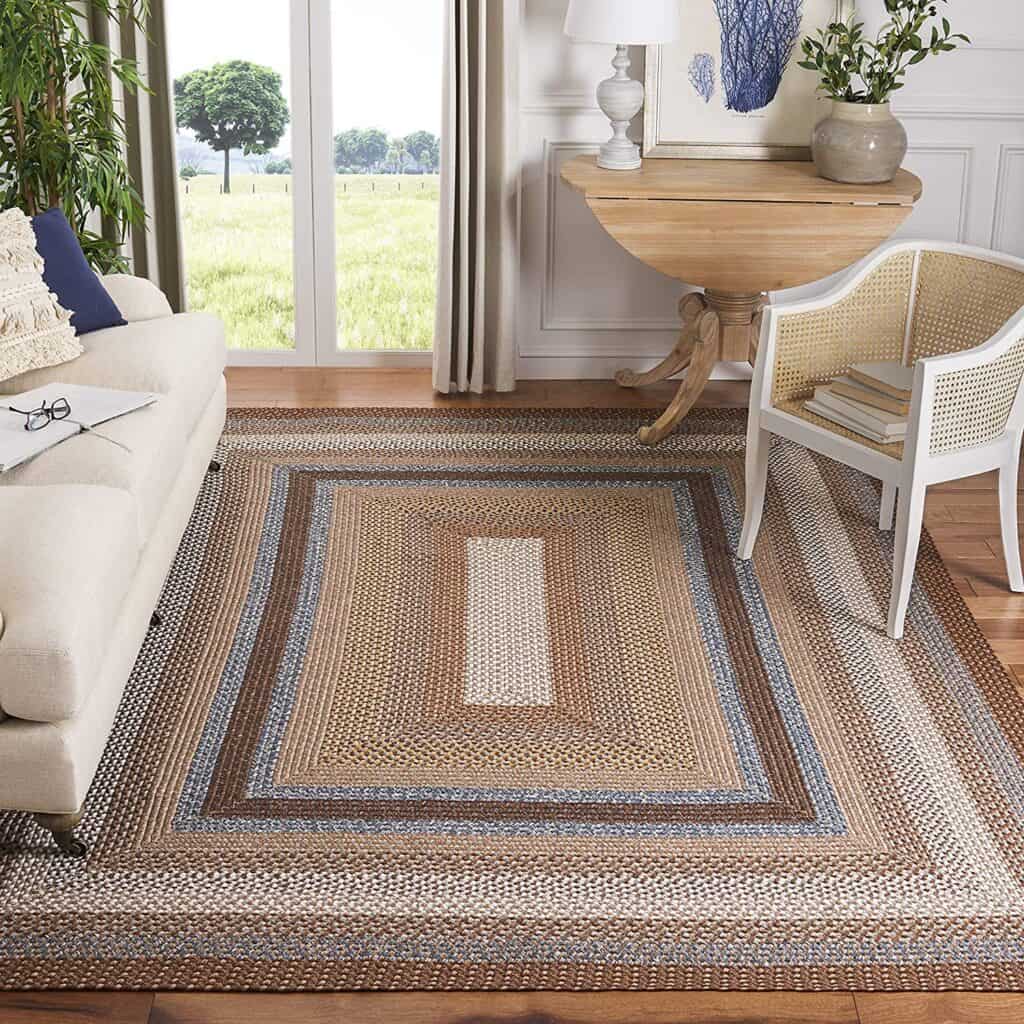
They’re also available in oval and circular shapes and various sizes.
5. Material of the Rug
It is important to consider the durability of the rug to be used in the home office, as it should be able to withstand the movement of chairs and traffic inside the office.
A rug’s durability, maintenance, aesthetics, etc., are mostly determined by the material used.
Please refer to the table below for a quick summary;
| Material of the Rug | Their Best Features |
|---|---|
| Silk | 1. Low Traffic Area 2. Not suitable for Home Office |
| Wool | 1. Best for High Traffic Area 2. Durable and Soft |
| Cotton | 1. Affordable than wool or silk 2. Best for casual spaces |
| Jute | 1. Best for high traffic and sunny areas 2. Very strong and renewable |
| Sisal | 1. Best for high traffic areas 2. Durable than jute |
| Faux Fur | 1. Not Suitable for Home Office 2. Makes chair gliding difficult |
| Polypropylene | 1. Cheaper than other material 2. Best for Home office and high traffic areas |
| Microfiber Polyester | 1. Affordable 2. Easy to clean |
Silk Rug
It’s best to avoid delicate materials like silk, bamboo silk, and artificial materials, as they’re easy to crush.
They can be made entirely of silk or a hand-knotted silk-wool blend.
Silk rugs are very delicate. So even in places with little foot traffic, they’re more typically mounted on walls than put on floors.
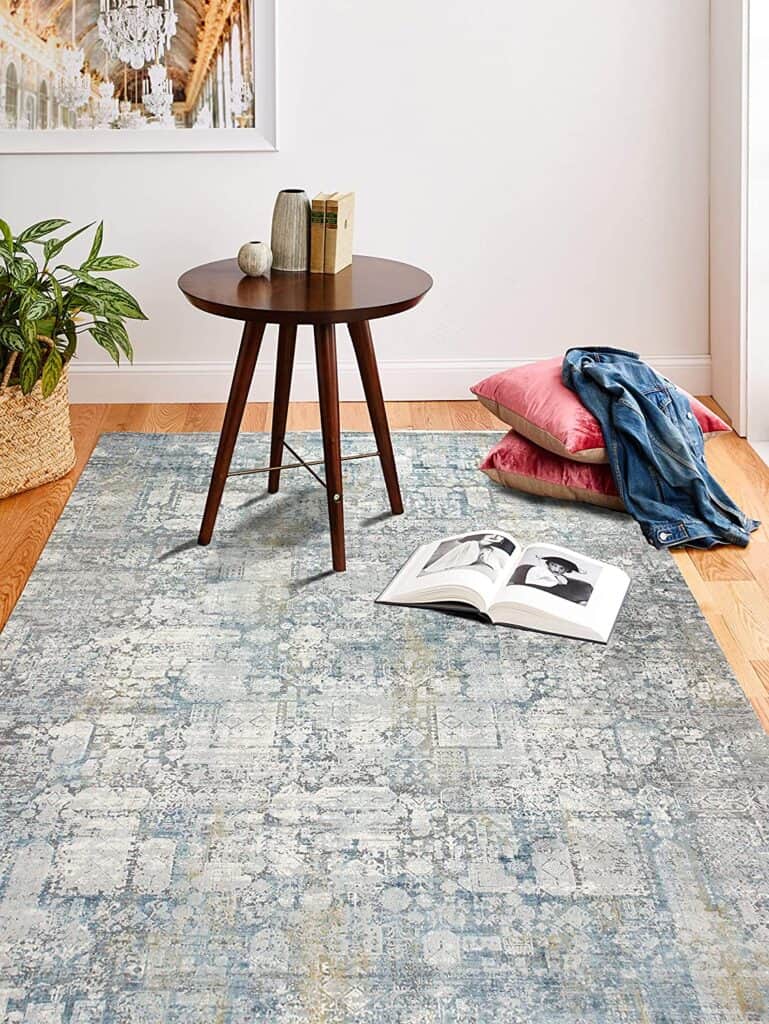
Pros of Silk Rugs
- Silk rugs are delicate and smooth to the touch.
- They do not lose shape.
Cons of Silk Rugs
- They also appear to be dirtier quickly due to their finer surface.
- They lose up to 20% of their strength when wet, making hot water and cleaning difficult.
- Furthermore, most vacuum cleaner heads harm silk carpets.
- They are among the most costly carpets available.
Woolen Rug
The most popular material used to make rugs is wool. It’s appealing since it’s both long-lasting and comfortable.
Pros of Woolen Rug
- Woolen rugs provide good insulation and may be treated to resist fluids and stains.
- It is suitable for high-traffic locations like offices.
- Wool is 100% biodegradable on the soil as it produces nitrogen, sulfur, carbon dioxide, and water, which are beneficial to plants.
- The woolen rug is extremely resistant to staining and oil-based fluids; non-oil-based liquids, particularly those with strong coloration, such as wine or coffee, can stain it.
Cons of Woolen Rug
- Wool absorbs humidity.
- It might shed, and the color might fade over time.
- It is Photosensitive; excessive exposure to direct sunshine can fade the colors in the fibers.
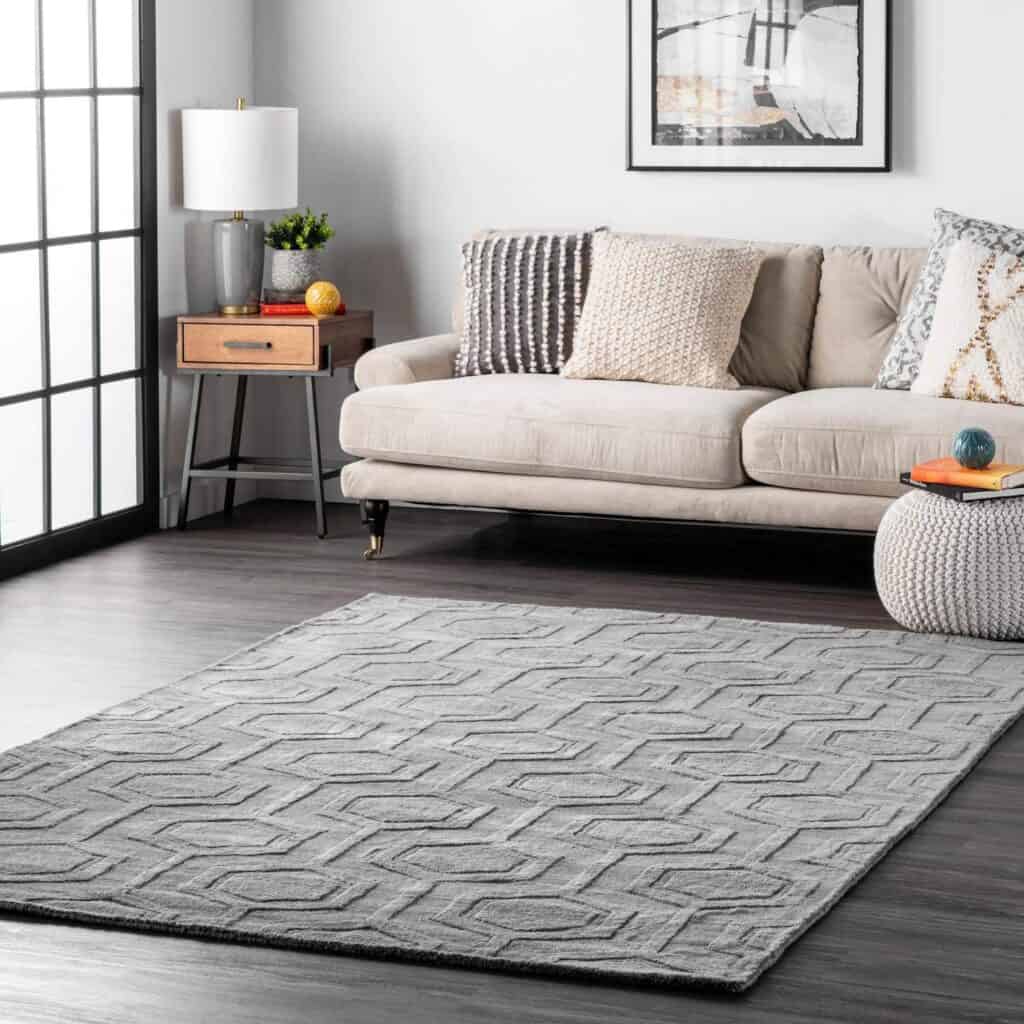
However, if you still want a woolen rug, Safavieh Abstract Handmade Premium Wool Area Rug is made from natural wool and adds a contemporary look to your home office with its geometric design patterns.
Cotton Rug
Flatweave carpets are often made of cotton. Cotton carpets have a casual touch to them.
Thus they should be used in informal areas with a relaxed atmosphere.
Pros of Cotton Rug
- Cotton rugs are available in a variety of colors and patterns.
- It is very comfortable.
- The cotton rug is easy to clean.
Cons of Cotton Rug
- It is less expensive than wool, but it is not as lasting. Therefore, it is not advised for use in a home office.
- It fades rapidly and does not repel stains.
Jute Rug
Rugs made of Jute are commonly used in home offices and living rooms.
Natural jute fiber can be used in high-traffic areas as it is extremely durable.
Pros of Jute Rug
- It is also available in a wide range of patterns.
- Jute rugs are soft since jute comes from plant fibers.
- It is a perfect choice for those with allergies as they are natural fibers.
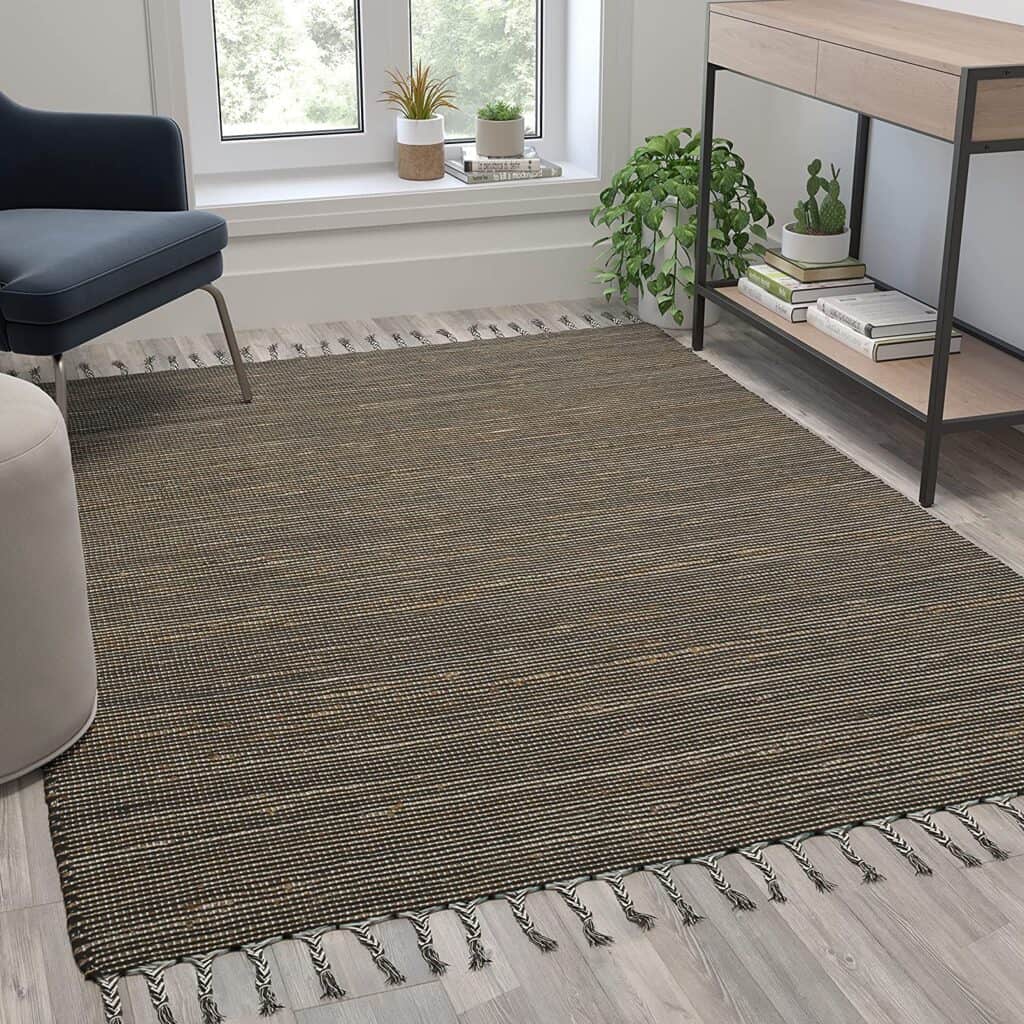
Cons of Cotton Rug
- The downside of using a jute rug is that it gets dirty quickly, and cleaning is very difficult.
- Dust is not easily visible on a jute rug but leaves fibers underneath it.
- It also cannot be steam cleaned as it is very absorbent. Absorbing water can lead to rug molding.
Sisal Rug
Sisal Rugs are also used in home offices in place of jute rugs.
Pros of Sisal Rug
- Sisal rugs are extremely durable, even more durable than jute.
- They are ideal for high-traffic areas that require a strong fabric.
Cons of Sisal Rug
- It has a coarser texture underfoot than other flat weave fibers like jute, polypropylene, and cotton.
- Although the fiber is durable, it should not be wet during cleaning since it might discolor and stretch the fibers.
Faux Fur Rug
Faux fur rug looks and feels extremely comfortable. However, it’s not the best choice in your home office.
Pros of Faux Fur Rug
- It provides warmth and comfort.
- It makes your home office look aesthetic.
Cons of Faux Fur Rug
- Gliding the chair through a faux fur rug is difficult.
- The fur can get easily trapped in the chair’s wheels.
- In addition, the faux fur sheds when it is new.
- Cleaning the faux fur rug is difficult, as it accumulates dust easily.
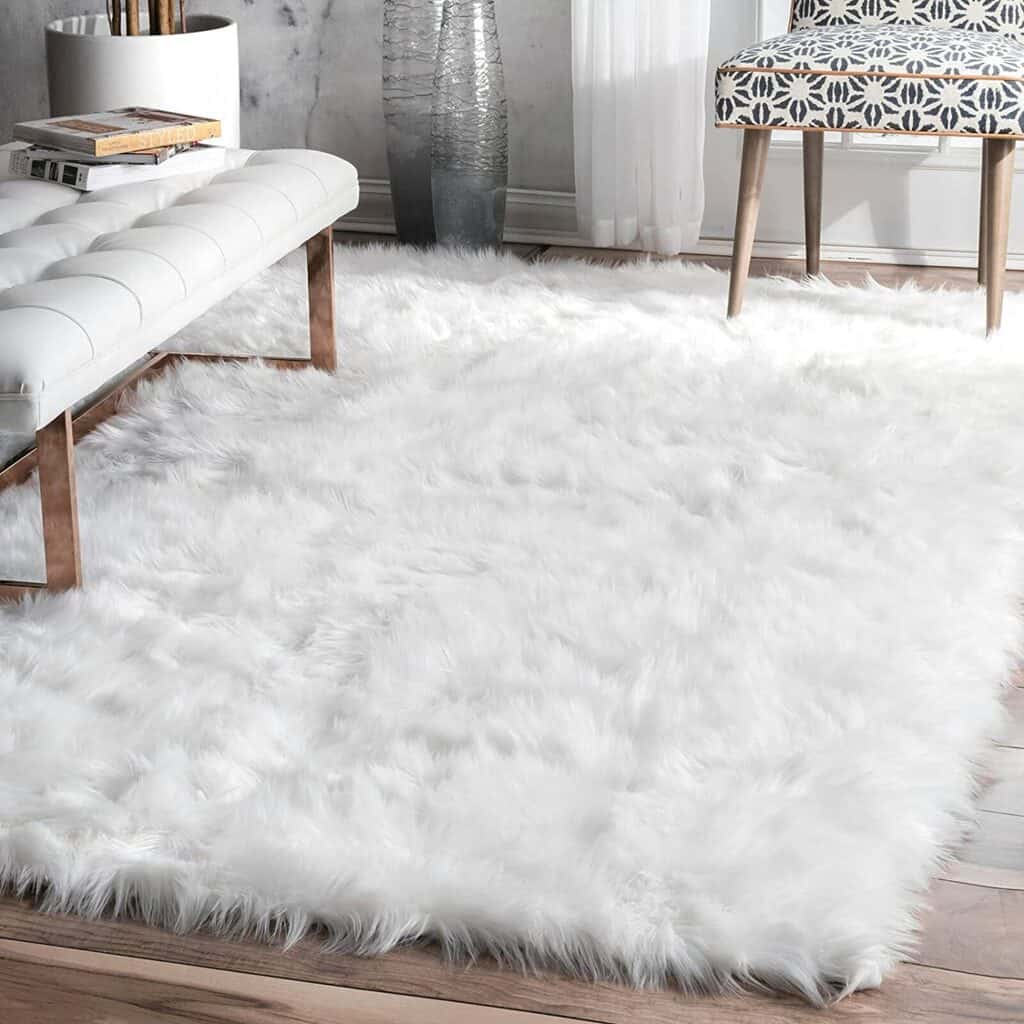
Polypropylene Rug
Synthetic materials are commonly used to produce rugs like polypropylene, nylon, polyester, etc.
The highlighting property of this material is certainly its affordability.
Pros of Polypropylene Rug
- Polypropylene rugs are soft to the touch and much thinner than woolen rugs.
- They are much easier to clean and are mostly fade-resistant.
- You can use them in your home office without worrying about high traffic or replacing them early.
Cons of Polypropylene Rug
- If you are highly environmentally conscious, opting out of using these rugs is best, as polypropylene does not decompose quickly.
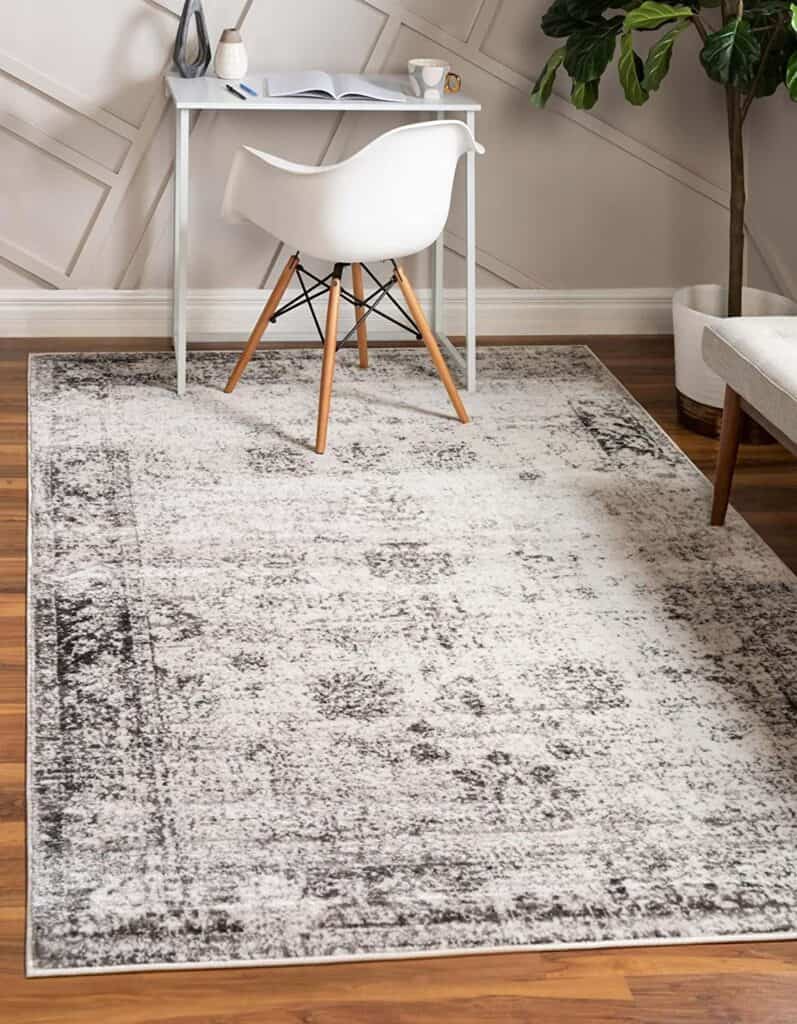
Microfiber Polyester Rugs
Other synthetic rug type includes microfiber rugs. These are either composed entirely of polyester or a combination of polyester and other synthetic fibers.
They’re mostly machine-woven, yet they might resemble more costly wool rugs.
Pros of Microfiber Polyester Rugs
- Synthetic rugs are often affordable, making them ideal for adding a splash of color without worrying about the cost.
Cons of Microfiber Polyester Rugs
- Since the smooth fibers can’t trap dirt, synthetic fiber rugs tend to seem dirtier sooner than actual wool or other natural fiber rugs.
Also read: Do office Chairs Ruin Carpets, mats, Rugs
6. Style and Color of the Rug
You can choose a rug color according to the color of your home office. In addition, you can choose a certain part of the room or its decor and match the rug color.
If you want to keep it simple, go for a solid-colored rug—any patterned furniture pairs well with solid colors.
However, if your furniture and decors have solid colors, choose the rug with patterns instead.
Boldly patterned rugs energize some individuals, while others prefer softer aesthetics to concentrate on their jobs.
It’s also crucial to consider the image you want to make if you meet business connections at your home office.
Basic neutrals, dark or subdued colors, or a combination of the two, will give the space a more formal appearance and set the tone for serious business discussions.
In addition, the rug should also match your interiors and your personality.
- If you want a modern-styled home office, solid colored rugs like JONATHAN Y Haze Solid Low-Pile Orange.
- If rustic decor matches your style, rugs with a soft color palette, like light blue and green, are perfect.
- Patterned rugs with floral and geometric prints will add a feminine touch to your home office.
An office should accentuate the style of your home while still having a distinct identity that fits your personality.
For more ideas on matching the rug to the home office, refer to the table below.
| Color Tone | Colors | Pairings |
|---|---|---|
| Deep and Dark | Dark blue, deep red or maroon | Well-suited rooms with white-walls or neutral, light colour palettes |
| Light and Lovely | Blush, Off white, Turquoise | A smaller sized room appears larger |
| Creative Contrasts | Emerald, aqua, Eggplant | Cooler tones for room with warm asthetic |
| Warm Tones | Red, orange, and yellow | Cooler tone wall color |
7. Consider Aesthetics
The home office Rug should also match perfectly with the office aesthetics. Below are some tips on matching the rug with office aesthetics.
- If you want your office to look professional or modern, use a Polypropylene rug.
- If Rustic aesthetics are more of your style, you can use, Natural fiber rugs like sisal and jute rugs.
- The traditional touch to your home office also makes a great office theme. For example, use rugs with Oriental and Persian patterns to add a traditional touch.
Related article: 12 Effective Ways to Improve Home Office Aesthetics
How to Place the Rug in your Home Office?
Rug placement pulls design aesthetics into a cohesive theme and can help your home office feel more organized and ordered.
- Home office rugs should typically go under a desk to highlight and feature the desk.
- Use a large rug so that your desk can be in the spotlight.
- Use a rug big enough to roll the chair out comfortably.
- Area rugs covering the desk and the chair are required in home offices.
- It can be accomplished by putting the rug under the front two legs of the desk and entirely under the chair, even when pushed out.
- Spread the rug as far as possible in all directions to produce a pleasant and cozy working environment.
- The bigger the rug, the more comfortable the space will look, but keep in mind that you can open and close the doors.
- Runner rugs may be utilized to separate and categorize a room.
- If you’re utilizing runners, ensure you measure and prepare ahead of time so your rugs have the look you desire in your workplace.
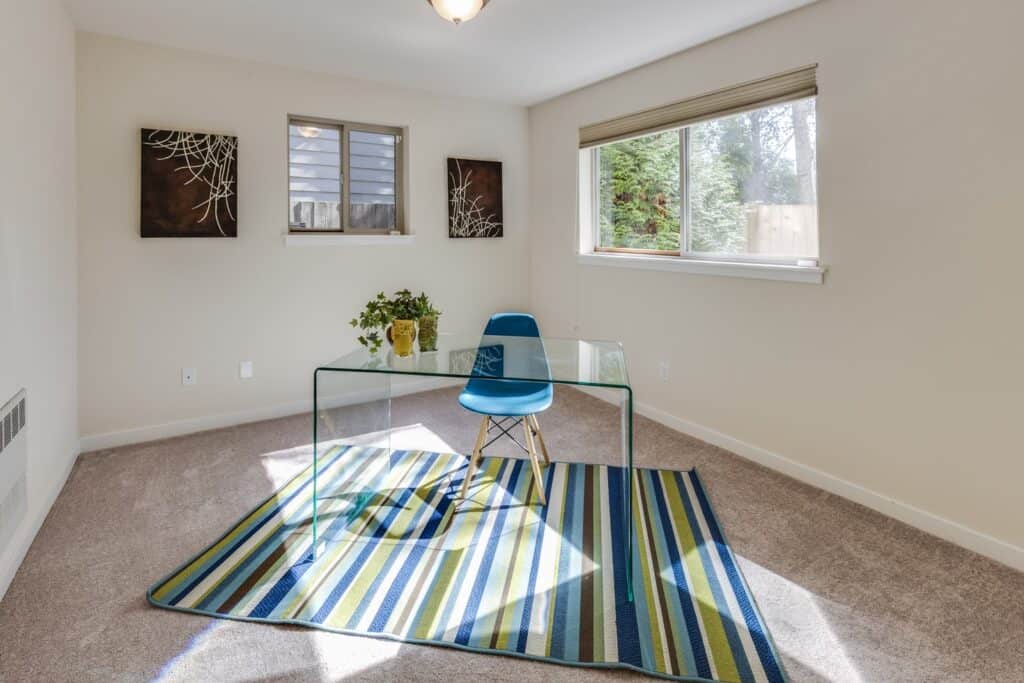
Rugs to Avoid for Rolling Office Chairs
Low-pile carpets make it easier for office chairs with wheels to move about and for heavy office equipment and furniture to fit.
Choose a hand-knotted rug with a pile height of 6mm or less rather than a thick shaggy design.
- High-Pile rugs do not allow easy gliding of chairs.
- A tufted rug with a raised woven design is likely inconvenient. Avoid the stumbling block of an office chair by opting for a flat weave rug instead.
- Natural fiber rugs, such as seagrass, jute, and sisal, don’t work well with rolling chairs. In addition, chairs might be stuck because of the loose weave of these natural fiber rugs.
- Cotton rugs have a very smooth surface. They are simple to roll over but easy to shift around.
- If you choose a cotton rug, ensure your chair is not too near the edge. If this is the case, use rug adhesive pads to keep the rug edge in place.
Also read: Pros and cons of putting a desk in the middle of a room
Frequently Asked Questions About the Rugs
Should a Rug be Placed Under a Desk?
Yes, you may put a rug under your office desk.
However, in other cases, such as floating or wall-mounted workstations, you should position the rug in front of the desk rather than below it.
Can you Layer Rugs for a Home Office?
Layering rugs work best in a room with plenty of space and very little furniture, such as a bedroom or living room.
Layering rugs under a chair can make chair movement uncomfortable, and the rugs on top are more likely to fold or shift with chair movement.
Should you Use a Rug on a Hardwood Floor?
Rugs can cause fading and discoloration on a wood floor. A rug prevents UV light from reaching the floor, fading uneven wood.
Moreover, dust can also get trapped under the rug and scratch the hardwood floor.
So, it is best to use alternatives like Bell glides, Standing desks, or rollerblade-style blades to protect your floor from the chair wheels rather than using rugs.
For more information, read the related article; Do Chair Mats Damage Hardwood Floors?
4. What do you Put Under Rugs?
You can use rug pads under the rugs.
Mainly, it prevents slips and falls. However, it also protects your rug and flooring.
You can also use a Rug Gripper or Rug Tape to prevent your Rug from slipping.
You may read: Should you Put your PC on the Carpet?
Final Verdict
Rugs used for a home office should perfectly match your office to work comfortably and improve the office’s appearance.
Rugs’ size, shape, color, style, type, etc., all determine your home office choice.
For instance, materials like wool, jute, and low-pile rugs are best for the home office.

